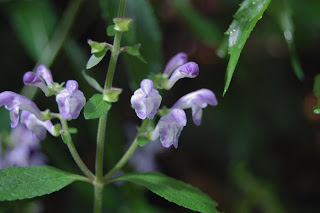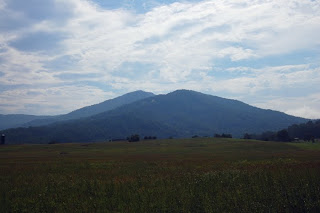We decided to escape the city for the long weekend and head for the Cranberry Wilderness in the Monongahela National Forest in West Virginia. The Cranberry Wilderness is a pretty amazing place. We spent five days backpacking there a few years ago and I was excited to get the chance to go back. The forest is dominated by birch and red cedars, which are usually found much farther north. Although some of the trails are relatively heavily used, the visitation is nothing like that in Shenandoah National Park. Many of the trails see very little use at all. This also means that the trails are not as well maintained, which is not a criticism. It just means that there are fewer signs and a lot more blowdowns to be negotiated than in a more heavily visited place.
Four of us headed out early on Friday morning for the long drive to West Virginia. Another was joining us on Saturday as he was not able to take the day off. We saw flame azaleas along the highway in the mountains as we drove into West Virginia. In spite of the good weather forecast (which, to be fair, included a chance of thunderstorms), we arrived at the trailhead in the middle of a lightning show and downpour. By the time we were ready to go, however, the storm had moved on.
We set off on the North Fork Trail and almost immediately encountered a blowdown. Beyond that, the mud started, which is all part of the fun of the Cranberry. We walked the 1.5 miles to the Middle Fork Trail, where we turned west to follow the Middle Fork of the Williams River. The Middle Fork Trail follows an old roadbed which is gently graded downhill all the way to the Williams River. It is easy walking and the trail is lined with rhododendrons. They were just starting to produce buds and will likely be in bloom around the end of June. Another thunderstorms rolled through, but did not last long. We saw a few wildflowers, including
Sculletaria sp. (Skullcap),
Hydrophyllum viginianum (Virginia Waterleaf), and
Potentilla simplex (Common Cinquefoil).
When we were here three years ago, the two stream crossings of the Middle Fork of the Williams were rockhops. Friday evening, they were fords. The Middle Fork was running high, cold, and fast from the rain over the previous few days. The second crossing was just over my knees and the water was cold enough to make my eyes water by the time I made it across.
We camped at Hell-For-Certain Branch, about 5.8 miles down the Middle Fork. There is a spectacular waterfall and a very nice established campsite there. Getting to the campsite required one last crossing of the Middle Fork. We set up camp and made dinner, which was bean burritos, complete with packets of guacamole. Just as we were ready to eat, another thunderstorm rolled in, so we wound up eating under a tarp. As an aside: the names in the Cranberry are interesting. In addition to Hell-for-Certain Branch, there is a Hateful Branch. One gets the idea that the people naming the streams did not much like the area, which would have been a forbidding forest then.
The next morning, the plan was to do a 13 mile loop dayhike, down the Middle Fork Trail to the Little Fork, up to the North South Trail, down the Laurelly Branch Trail, and back up the Middle Fork Trail to our campsite on Hell-For-Certain Branch. I was a little concerned about the crossing of the Middle Fork since we would have to cross it just above where it joins with the Williams River. Even if we were turned back by the ford, there, though, we would still hike a respectable 9.5 miles.
After a leisurely breakfast and coffee, we crossed the Middle Fork to get to the trail and set off. We took a quick break at Beechy Run, where a nice waterfall cascades just below the stream crossing. The trail was plenty muddy, but we made good time and soon arrived at the parking lot at the west side of the Wilderness Area. Our map showed the County Line Trail splitting off to the northeast and then the junction of the Little Fork Trail heading south, just to the west of that. We looked, in vain, for the Little Fork Trail for almost 45 minutes. After eating lunch, we took another look at the map and decided, given the landmarks, we could safely bushwhack to find the trail. I
do not recommend that everyone try this, but we had a good map, compass, and lots of prior practice in navigation. We knew that the Middle Fork was just south of us, the Williams River was to the west and the Little Fork had to be south and east of us.
We quickly crossed the Middle Fork and headed uphill. We found a path that followed an old roadbed and checked the compass bearing. It was headed in the right direction, so we followed it. We came around a corner and there was the Little Fork trail, complete with bright blue blazes (we were on the edge of the Cranberry Backcountry - as opposed to Wilderness - where trails are blazed)! Given the blazes, we were even more mystified as to how we missed the trailhead. We followed the Little Fork Trail for a short distance until we reached the Little Fork of the Williams River.
At that point, we had spent over 90 minutes, including our initial search for the trailhead, to go half a mile. We decided that, given the time and how far we had yet to go on the loop, it made the most sense to turn back. We were also curious to see where the Little Fork Trail joined the Middle Fork Trail. We crossed the Middle Fork again and soon arrived at the Middle Fork Trail - east of the junction with the County Line Trail. Our map had put the Little Fork Trail in the wrong place, which meant we were looking in the wrong place. The Little Fork trailhead was also completely overgrown, making it harder to find.
In spite of having to change our plans, we still had a good hike and the navigation challenge was a fun puzzle to figure out. We returned to our campsite and got to enjoy the late afternoon sun. I spent some time taking pictures of the waterfalls around the campsite. Just before dinner, the fifth member of our party came strolling into camp. We made dinner - vegetable soup with rice noodles - and said around the empty fire ring talking.
One Sunday morning, we made breakfast and had coffee before breaking camp. We hiked down the Middle Fork Trail again to Beechy Run. This time, we turned north on the Big Beechy Trail. The Middle Fork Trail sees a fair amount of use. Although the Big Beechy Trail connects to the Middle Fork Trail, it might as well be in another county. Away from the campsites and river, few people venture up it. The Big Beechy Trail gets a fraction of the use that the Middle Fork Trail does. Although they are missing a great trail, the selfish part of me is glad that we had the trail to ourselves.
The trail climbs quickly out of the Middle Fork valley. It is only about six inches wide in most places until it reaches the top of the ridge and there are blowdowns every few hundred yards. The slope fell steeply away towards Beechy Run, far below us in the valley. In short, it is a pretty interesting trail. On top of the ridge, the trail passes through groves of red cedar, birches, and hemlocks. In places that were too rugged to log, there are actually some old growth trees that escaped the mass logging of the eastern U.S. There are large flat boulders with trees growing on top of them, their roots wrapped around the sides as though they are holding on for dear life. In other areas, knee-high ferns nearly covered the trail. We ran into some late
Clintonia borealis (Clintonia Lily) and one very late
Trillium undulatum (Painted Trillium).
At the end of the day, the trail connected back with the North Fork Trail. We hiked past the parking area to the first campsite on the Middle Fork Trail (which we had passed on the first night). We discussed simply hiking out that night, but decided that it was too long to drive after a long day of hiking. In the morning, we would have a short hike out to the car. We set up camp and had dinner, Indian vegetables and rice. While we were eating, two helicopters flew over very low. We might have been mistaken, but we are pretty sure one of them was Marine One, the President's Helicopter. Just after everyone crawled into their tent or hammock, it started raining - a final thunderstorm to end the weekend.
We will definitely return to the Cranberry.
Pictures (click to enlarge):
Day 1: Crossing the Middle Fork of the Williams River
Medeola virginiana (Indian Cucumber Root)
Hydrophyllum viginianum (Virginia Waterleaf)
Sculletaria sp. (Skullcap)
Day 2: The sun streaming through the trees in the morning near our campsite on Hell-For-Certain Branch.
The morning sun shining on the Middle Fork of the Williams River.
The waterfall on Beechy Run.
The overgrown Little Fork Trailhead. The post should have been a tipoff, but the map threw us off, placing the trailhead several hundred yards west of where it actually is.
A newt along the Middle Fork Trail.
The Middle Fork Trail near the Laurelly Branch Trail.
The waterfall on Hell-for-Certain Branch near our campsite.
A small cascade near our campsite on Hell-for-Certain Branch.
A mound of moss near the campsite on Hell-for-Certain Branch
Day 3: The Big Beechy Trail climbing away from the Middle Fork
Oxalis montana (Wood Sorrel)
Viola blanda (Sweet White Violet). This is a tiny violet; the flower only measures about half an inch.
A neat example of a tree with its roots growing around a large rock.
Clintonia borealis (Clintonia Lily)
A grove of ferns along the trail.
A tiny
Maianthemum canadense (Canada Mayflower or Wild Lily of the Valley). These plants are two to three inches tall.
A very late, fading
Trillium undulatum (Painted Trillium)
An old U.S. Coast and Geodetic Survey marker at our final campsite. This one was placed in 1962. There are at least two of these along the Middle Fork Trail. They mark points of known elevation and are reference points for the creation of maps. The Coast and Geodetic Survey became the
National Geodetic Survey, which is now part of the
National Oceanic & Atmospheric Administration.






































































